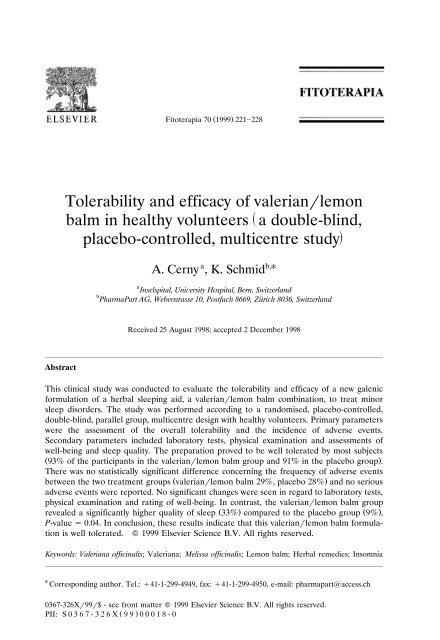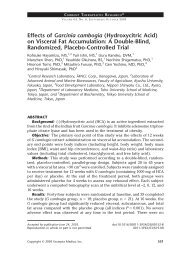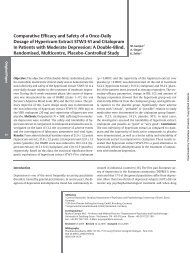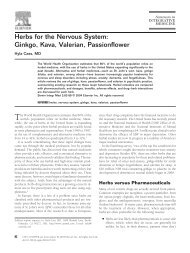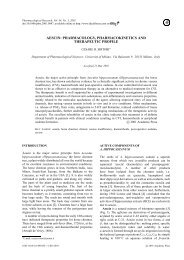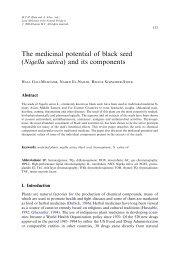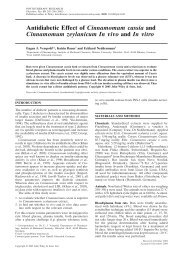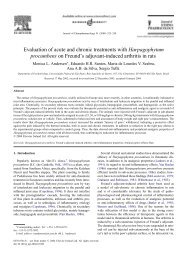Tolerability and efficacy of valerianrlemon ž balm in ... - Nutraxin
Tolerability and efficacy of valerianrlemon ž balm in ... - Nutraxin
Tolerability and efficacy of valerianrlemon ž balm in ... - Nutraxin
Create successful ePaper yourself
Turn your PDF publications into a flip-book with our unique Google optimized e-Paper software.
Abstract<br />
Ž .<br />
Fitoterapia 70 1999 221�228<br />
<strong>Tolerability</strong> <strong>and</strong> <strong>efficacy</strong> <strong>of</strong> valerian�lemon<br />
<strong>balm</strong> <strong>in</strong> healthy volunteers <strong>ž</strong> a double-bl<strong>in</strong>d,<br />
placebo-controlled, multicentre study/<br />
A. Cerny a , K. Schmid b,�<br />
a Inselspital, Uni�ersity Hospital, Bern, Switzerl<strong>and</strong><br />
b PharmaPart AG, Weberstrasse 10, Postfach 8669, Zurich 8036, Switzerl<strong>and</strong><br />
¨<br />
Received 25 August 1998; accepted 2 December 1998<br />
This cl<strong>in</strong>ical study was conducted to evaluate the tolerability <strong>and</strong> <strong>efficacy</strong> <strong>of</strong> a new galenic<br />
formulation <strong>of</strong> a herbal sleep<strong>in</strong>g aid, a valerian�lemon <strong>balm</strong> comb<strong>in</strong>ation, to treat m<strong>in</strong>or<br />
sleep disorders. The study was performed accord<strong>in</strong>g to a r<strong>and</strong>omised, placebo-controlled,<br />
double-bl<strong>in</strong>d, parallel group, multicentre design with healthy volunteers. Primary parameters<br />
were the assessment <strong>of</strong> the overall tolerability <strong>and</strong> the <strong>in</strong>cidence <strong>of</strong> adverse events.<br />
Secondary parameters <strong>in</strong>cluded laboratory tests, physical exam<strong>in</strong>ation <strong>and</strong> assessments <strong>of</strong><br />
well-be<strong>in</strong>g <strong>and</strong> sleep quality. The preparation proved to be well tolerated by most subjects<br />
Ž 93% <strong>of</strong> the participants <strong>in</strong> the valerian�lemon <strong>balm</strong> group <strong>and</strong> 91% <strong>in</strong> the placebo group . .<br />
There was no statistically significant difference concern<strong>in</strong>g the frequency <strong>of</strong> adverse events<br />
between the two treatment groups Ž valerian�lemon <strong>balm</strong> 29%, placebo 28% . <strong>and</strong> no serious<br />
adverse events were reported. No significant changes were seen <strong>in</strong> regard to laboratory tests,<br />
physical exam<strong>in</strong>ation <strong>and</strong> rat<strong>in</strong>g <strong>of</strong> well-be<strong>in</strong>g. In contrast, the valerian�lemon <strong>balm</strong> group<br />
revealed a significantly higher quality <strong>of</strong> sleep Ž 33% . compared to the placebo group Ž 9% . ,<br />
P-value � 0.04. In conclusion, these results <strong>in</strong>dicate that this valerian�lemon <strong>balm</strong> formulation<br />
is well tolerated. � 1999 Elsevier Science B.V. All rights reserved.<br />
Keywords: Valeriana <strong>of</strong>fic<strong>in</strong>alis; Valeriana; Melissa <strong>of</strong>fic<strong>in</strong>alis; Lemon <strong>balm</strong>; Herbal remedies; Insomnia<br />
� Correspond<strong>in</strong>g author. Tel.: �41-1-299-4949, fax: �41-1-299-4950, e-mail: pharmapart@access.ch<br />
0367-326X�99�$ - see front matter � 1999 Elsevier Science B.V. All rights reserved.<br />
Ž .<br />
PII: S 0 3 6 7 - 3 2 6 X 9 9 0 0 018-0
222<br />
1. Introduction<br />
( )<br />
A. Cerny, K. Schmid � Fitoterapia 70 1999 221�228<br />
Insomnia is a common problem among the general population <strong>in</strong> the Western<br />
world. In Germany, for <strong>in</strong>stance, up to 18% <strong>of</strong> the population occasionally suffer<br />
from some k<strong>in</strong>d <strong>of</strong> sleep<strong>in</strong>g problem �� 1 . Approximately 7% <strong>of</strong> Germans compla<strong>in</strong><br />
about frequent problems <strong>in</strong> fall<strong>in</strong>g asleep or sleep<strong>in</strong>g through the night. Of these,<br />
44% use hypnotics on a regular basis. The preferred choice <strong>and</strong> most widely used<br />
are the benzodiazep<strong>in</strong>e receptor agonist type drugs Žbenzodiazep<strong>in</strong>es,<br />
cyclopyrrolones,<br />
imidazopyrid<strong>in</strong>es. <strong>and</strong> barbiturates. The use <strong>of</strong> these drugs, however,<br />
is generally not <strong>in</strong>dicated for <strong>in</strong>dividuals who are affected with m<strong>in</strong>or sleep<strong>in</strong>g<br />
disorders. Their adverse effect pr<strong>of</strong>ile Žrebound<br />
<strong>and</strong> ‘hang-over’ effects, reduced<br />
concentration <strong>and</strong> efficiency dur<strong>in</strong>g the day, modification <strong>of</strong> the various phases <strong>of</strong><br />
sleep. <strong>and</strong> the danger <strong>of</strong> physical addiction require a careful <strong>and</strong> restricted usage<br />
<strong>of</strong> these drugs.<br />
In search <strong>of</strong> alternatives, <strong>in</strong>terest has been shifted to herbal sedatives �� 2 , which<br />
have been used <strong>in</strong> folk medic<strong>in</strong>e as mild sleep<strong>in</strong>g aids for centuries. The use <strong>of</strong><br />
such herbal preparations, however, is still controversial, as their <strong>efficacy</strong> <strong>and</strong><br />
tolerability has not yet been scientifically established.<br />
As phytopharmacology, a predom<strong>in</strong>antly empirical science, is now on its way to<br />
becom<strong>in</strong>g an established medic<strong>in</strong>al science �� 3 , systematic research to demonstrate<br />
effects, <strong>efficacy</strong> <strong>and</strong> safety <strong>of</strong> herbal remedies <strong>in</strong> man is highly desirable.<br />
The last years have produced a number <strong>of</strong> controlled, double-bl<strong>in</strong>d studies which<br />
demonstrated the <strong>efficacy</strong> <strong>and</strong> tolerability <strong>of</strong> some s<strong>in</strong>gle compound preparations<br />
conta<strong>in</strong><strong>in</strong>g valerian Ž Valeriana <strong>of</strong>fic<strong>in</strong>alis. �4�7 �, kava�kava Ž Piper methysticum.<br />
�8�10 �, or St John’s wort Ž Hypericum perforatum. �11�13 �.<br />
For other preparations,<br />
e.g. lemon <strong>balm</strong> Ž Melissa <strong>of</strong>fic<strong>in</strong>alis . , or the comb<strong>in</strong>ation <strong>of</strong> valerian�lemon <strong>balm</strong> or<br />
valerian�hops Ž Humulus lupulus. data are still scarce �� 1 . The present study was<br />
designed to determ<strong>in</strong>e the safety <strong>of</strong> a new galenic formulation <strong>of</strong> a valerian�lemon<br />
<strong>balm</strong> preparation <strong>and</strong> to provide <strong>in</strong>dications <strong>of</strong> its <strong>efficacy</strong> Žas<br />
far as possible <strong>in</strong><br />
healthy volunteers not suffer<strong>in</strong>g from <strong>in</strong>somnia . .<br />
2. Experimental<br />
2.1. Experimental design <strong>and</strong> procedure<br />
The study was performed accord<strong>in</strong>g to a r<strong>and</strong>omised, placebo-controlled,<br />
double-bl<strong>in</strong>d, parallel group, multicentre design. It was coord<strong>in</strong>ated by a CRO <strong>and</strong><br />
carried out at three different hospital units <strong>and</strong> three general practices <strong>in</strong> Switzerl<strong>and</strong>.<br />
Primary endpo<strong>in</strong>ts were the assessment <strong>of</strong> the overall tolerability <strong>of</strong> the preparation<br />
on a 5-po<strong>in</strong>t rat<strong>in</strong>g scale Žexcellent,<br />
good, moderate, acceptable <strong>and</strong> unsatisfac-
( )<br />
A. Cerny, K. Schmid � Fitoterapia 70 1999 221�228 223<br />
tory. <strong>and</strong> the <strong>in</strong>cidence <strong>of</strong> adverse events Ž AE . . Secondary endpo<strong>in</strong>ts were laboratory<br />
parameters, physical exam<strong>in</strong>ation, sleep quality <strong>and</strong> well-be<strong>in</strong>g.<br />
At enrolment, <strong>in</strong>clusion <strong>and</strong> exclusion criteria were checked; demographics,<br />
medical history, smok<strong>in</strong>g <strong>and</strong> dr<strong>in</strong>k<strong>in</strong>g habits were recorded, <strong>and</strong> <strong>in</strong>formed consent<br />
was obta<strong>in</strong>ed. A short physical exam<strong>in</strong>ation <strong>and</strong> laboratory tests were performed.<br />
The volunteers were asked to rate their well-be<strong>in</strong>g <strong>and</strong> their sleep quality on a 100<br />
mm visual analogue scale Ž VAS . . At the second visit, the physical exam<strong>in</strong>ation, the<br />
laboratory tests <strong>and</strong> the rat<strong>in</strong>g <strong>of</strong> well-be<strong>in</strong>g <strong>and</strong> sleep quality were repeated. In<br />
addition, compliance <strong>and</strong> adverse events were assessed.<br />
Physical exam<strong>in</strong>ation parameters exam<strong>in</strong>ed were blood pressure, pulse <strong>and</strong><br />
weight. Laboratory parameters tested were: haemoglob<strong>in</strong>, RBC, WBC <strong>and</strong> platelets,<br />
creat<strong>in</strong><strong>in</strong>e, alkal<strong>in</strong>e phosphatase, ALT Ž SGPT . , AST Ž SGOT . , �-GT, sodium <strong>and</strong><br />
potassium.<br />
2.2. Subjects<br />
This study was carried out with healthy volunteers <strong>of</strong> both genders, 20�70-year<br />
olds. ‘Healthy’ was def<strong>in</strong>ed as fit for work <strong>and</strong> absence <strong>of</strong> a serious disorder, which<br />
might <strong>in</strong>terfere with the evaluation <strong>of</strong> the safety <strong>of</strong> the test drug Že.g.<br />
renal<br />
<strong>in</strong>sufficiency, hepatic dysfunction, cardiovascular, disease, or psychic disorder. or<br />
known abnormal values <strong>of</strong> the laboratory tests.<br />
Further exclusion criteria were drug <strong>and</strong> alcohol abuse, concomitant treatment<br />
with other drugs, <strong>in</strong>clud<strong>in</strong>g herbal sedatives, <strong>in</strong>terfer<strong>in</strong>g with the evaluation <strong>of</strong> the<br />
test drug; known hypersensitivity to any <strong>of</strong> the <strong>in</strong>gredients <strong>of</strong> the study drug;<br />
pregnancy, lactation, women <strong>of</strong> childbear<strong>in</strong>g potential who did not use an established<br />
contraceptive; <strong>and</strong> participation <strong>in</strong> another study with<strong>in</strong> the last 30 days.<br />
2.3. Ethical appro�al<br />
The study was conducted <strong>in</strong> accordance with <strong>in</strong>ternational GCP regulations <strong>and</strong><br />
the Declaration <strong>of</strong> Hels<strong>in</strong>ki <strong>of</strong> the World Medical Association. Approvals <strong>of</strong> ethical<br />
committees <strong>and</strong> regulatory authorities were obta<strong>in</strong>ed before start<strong>in</strong>g volunteer<br />
recruitment. Prior to enrolment, each volunteer received an explanation as to the<br />
aim <strong>and</strong> risks <strong>of</strong> the study <strong>and</strong> gave his�her written <strong>in</strong>formed consent.<br />
2.4. Drug <strong>and</strong> treatment<br />
� Ž �<br />
The test drug coated tablets <strong>of</strong> valerian�lemon <strong>balm</strong> Songha Night , Pharmaton<br />
Natural Health Products, Bioggio�Lugano, Switzerl<strong>and</strong>.� conta<strong>in</strong>ed 120 mg<br />
valerian extract Ž extr. valerianae e. rad. spir. sicc. 4.5:1. <strong>and</strong> 80 mg lemon <strong>balm</strong><br />
extract Ž extr. melissae e. fol. sicc. 5:1 . . The comparator placebo visually matched<br />
the test drug.<br />
The volunteers were <strong>in</strong>structed to take three tablets daily, <strong>in</strong> one dose, 0.5 h<br />
before bed-time. The total daily dose for volunteers <strong>in</strong> the valerian�lemon <strong>balm</strong>
224<br />
( )<br />
A. Cerny, K. Schmid � Fitoterapia 70 1999 221�228<br />
group was thus 360 mg valerian <strong>and</strong> 240 mg lemon <strong>balm</strong>. The treatment duration<br />
was 30 days.<br />
2.5. Statistical methods<br />
Categorical data were analysed by us<strong>in</strong>g the � 2 test, cont<strong>in</strong>uous data were<br />
analysed by the Student’s t-test. P-values � 0.05 were considered significant.<br />
3. Results<br />
3.1. Subjects <strong>and</strong> treatment<br />
N<strong>in</strong>ety-eight healthy volunteers Ž 58 women <strong>and</strong> 40 men. were enrolled <strong>in</strong> this<br />
study Ž Table 1 . . Mean age <strong>of</strong> the volunteers <strong>in</strong> the valerian�lemon <strong>balm</strong> group was<br />
33.4 Ž S.D. 12.5. years, mean age <strong>of</strong> the volunteers <strong>in</strong> the placebo group was 34.8<br />
Ž S.D. 11.7. years. By 2:1 r<strong>and</strong>omisation, 66 were allocated to the valerian�lemon<br />
<strong>balm</strong> group, <strong>and</strong> 32 to the placebo group.<br />
All participants were <strong>in</strong>cluded <strong>in</strong> the tolerability evaluation: 97% <strong>of</strong> the valerian�lemon<br />
<strong>balm</strong> group <strong>and</strong> 94% <strong>of</strong> the placebo group showed good�acceptable<br />
compliance. One volunteer <strong>in</strong> the placebo group stopped tak<strong>in</strong>g the medication<br />
early because <strong>of</strong> nausea <strong>and</strong> <strong>in</strong>somnia, which was considered drug-related. Two<br />
volunteers <strong>in</strong> the valerian�lemon <strong>balm</strong> group discont<strong>in</strong>ued because <strong>of</strong> lack<strong>in</strong>g<br />
<strong>efficacy</strong>, <strong>and</strong> nausea <strong>and</strong> sleep disturbances, respectively.<br />
3.2. <strong>Tolerability</strong> rat<strong>in</strong>g<br />
The overall tolerability was rated on a 5-po<strong>in</strong>t rat<strong>in</strong>g-scale by question<strong>in</strong>g the<br />
volunteers after 30 days <strong>of</strong> treatment. In general, the preparation was very well<br />
tolerated Ž Fig. 1 . : 97.0% <strong>of</strong> participants <strong>in</strong> the valerian�lemon <strong>balm</strong> group <strong>and</strong><br />
96.9% <strong>of</strong> participants <strong>in</strong> the placebo group reported acceptable to excellent<br />
tolerability. Only 3.0% <strong>and</strong> 3.1%, respectively, <strong>of</strong> the volunteers considered the<br />
Table 1<br />
Synopsis: demographic data Ž Mean, S.D. .<br />
Volunteers Valerian� Placebo<br />
lemon <strong>balm</strong><br />
Total 66 32<br />
Females 38 20<br />
Males 28 12<br />
Mean age Ž years. 33.4 Ž 12.5. 34.8 Ž 11.7.<br />
Mean weight Ž kg. 66.8 Ž 11.8. 65.6 Ž 9.3.<br />
Mean height Ž cm. 173.0 Ž 10.5. 170.8 Ž 9.0.
( )<br />
A. Cerny, K. Schmid � Fitoterapia 70 1999 221�228 225<br />
Fig. 1. Rat<strong>in</strong>g <strong>of</strong> tolerability after 30 days <strong>of</strong> treatment valerian�lemon <strong>balm</strong> vs. placebo.<br />
overall tolerability as unsatisfactory. There was no statistically significant differ-<br />
Ž .<br />
ence <strong>in</strong> tolerability between the two treatment groups P � 0.76 .<br />
3.3. Ad�erse e�ents<br />
Twenty-eight Ž 28.6% . volunteers reported adverse events. The proportion <strong>of</strong><br />
volunteers report<strong>in</strong>g adverse events was similar <strong>in</strong> both treatment groups: 28.8% <strong>in</strong><br />
the valerian�lemon <strong>balm</strong> group <strong>and</strong> 28.1% <strong>in</strong> the placebo group. Sleep disturbances<br />
<strong>and</strong> tiredness were the two most frequent adverse events. Their frequencies<br />
were similar <strong>in</strong> the two treatment groups valerian�lemon <strong>balm</strong> vs. placebo Ž12%<br />
vs.<br />
13% . <strong>and</strong> Ž 11% vs. 13% . , respectively. No severe adverse events were reported<br />
dur<strong>in</strong>g this study.<br />
3.4. Laboratory tests <strong>and</strong> physical exam<strong>in</strong>ation<br />
The mean values <strong>of</strong> blood pressure, pulse rate, body weight <strong>and</strong> laboratory test<br />
results at the beg<strong>in</strong>n<strong>in</strong>g <strong>and</strong> the end <strong>of</strong> the study did not change throughout the<br />
study <strong>and</strong> there were no statistically significant differences between the two<br />
treatment groups Ž Table 2 . .<br />
3.5. Sleep quality<br />
When questioned dur<strong>in</strong>g the second visit 33.3% <strong>of</strong> the volunteers <strong>in</strong> the<br />
valerian�lemon <strong>balm</strong> group <strong>and</strong> 9.4% <strong>in</strong> the placebo group reported an improvement<br />
<strong>in</strong> sleep quality Ž P � 0.04. Ž Fig. 2 . . This, however, was not reflected by the<br />
analysis <strong>of</strong> the results from the visual analogue scale <strong>of</strong> sleep quality Ž 0�100 mm . .<br />
It revealed only a slight but not statistically significant improvement <strong>in</strong> sleep<br />
quality <strong>in</strong> both treatment groups over the 30 days treatment period, valerian�lemon<br />
<strong>balm</strong> from 74 mm Ž S.D. 23. to 76 mm Ž S.D. 23. <strong>and</strong> placebo from 77 mm Ž S.D. 19.<br />
to 79 mm Ž S.D. 19 . .
226<br />
( )<br />
A. Cerny, K. Schmid � Fitoterapia 70 1999 221�228<br />
Table 2<br />
Results <strong>of</strong> haematology <strong>and</strong> blood chemistry tests Ž Mean, S.D. .<br />
Visit 1 T Visit 2 T<br />
Ž . Ž .<br />
Day 0 Day 30<br />
Haematology<br />
Haemoglob<strong>in</strong> V�LB 14.3 Ž 1.7. 0.228 14.3 Ž 1.5. 0.004<br />
�1 Ž g dl . Placebo 14.4 Ž 1.5. 14.3 Ž 1.5.<br />
Red blood cells V�LB 4.7 Ž 0.5. 0.219 4.7 Ž 0.5. �0.068<br />
�1 Ž 10E12 l . Placebo 4.7 Ž 0.5. 4.7 Ž 0.4.<br />
White blood cells V�LB 6.3 Ž 1.7. 0.339 6.3 Ž 1.8. 1.340<br />
�1 Ž 10E9 l . Placebo 6.5 Ž 1.6. 6.9 Ž 2.0.<br />
Platelets V�LB 254.1 Ž 54.0. �1.136 250.6 Ž 50.5. 0.679<br />
�1 Ž 10E9 l . Placebo 241.7 Ž 48.9. 242.9 Ž 56.5.<br />
Blood chemistry<br />
Potassium V�LB 4.2 Ž 0.7. �0.966 4.0 Ž 0.4. 0.348<br />
�1 Ž mmol l . Placebo<br />
�<br />
4.1 Ž 0.4. 4.1 Ž 0.4.<br />
Sodium V�LB 142.0 Ž 3.1. 0.963 141.6 Ž 3.3. 0.439<br />
�1 Ž mmol l . Placebo 142.6 Ž 2.5. 141.9 Ž 2.9.<br />
Creat<strong>in</strong><strong>in</strong>e V�LB 85.5 Ž 18.1. �1.59 85.0 Ž 15.6. �1.123<br />
�1 Ž �mol l . Placebo 81.7 Ž 10.4. 81.7 Ž 14.2.<br />
Alk. phosphatase V�LB 57.2 Ž 17.9. 0.281 56.0 Ž 16.9. �0.993<br />
�1 Ž IU l . Placebo 54.0 Ž 15.9. 59.8 Ž 19.2.<br />
ALT Ž SGPT. V�LB 10.0 Ž 13.6. �0.505 20.2 Ž 11.2. 0.612<br />
�1 Ž IU l . Placebo 18.8 Ž 10.1. 20.2 Ž 10.4.<br />
AST Ž SGOT. V�LB 20.6 Ž 6.5. 0.612 20.8 Ž 7.5. 0.686<br />
�1 Ž IU l . Placebo 19.7 Ž 5.7. 18.6 Ž 9.7.<br />
Gamma-GT V�LB 16.5 Ž 12.2. 0.831 16.3 Ž 12.8. �1.150<br />
�1 Ž IU l . Placebo 14.6 Ž 9.9. 13.4 Ž 9.3.<br />
Vital signs<br />
Blood pressure<br />
Systolic Ž mmHg. V�LB 118.5 Ž 13.4. 0.526 119.9 Ž 12.3. 0.874<br />
Placebo 116.9Ž 14.2. 117.3Ž 14.2.<br />
Diastolic Ž mmHg. V�LB 71.9 Ž 8.3. 0.385 72.7 Ž 8.9. 0.371<br />
Placebo 71.3 Ž 8.0. 71.9 Ž 9.9.<br />
Pulse rate V�LB 70.8 Ž 9.3. �0.034 72.0 Ž 10.5. �0.611<br />
Placebo 70.8 Ž 9.3. 70.7 Ž 8.9.<br />
V�LB � Valerian�Lemon Balm.<br />
Ž� V�LB: N � 66; Placebo: N � 32 Placebo: N � 31 . .<br />
3.6. Well-be<strong>in</strong>g<br />
After 30 days <strong>of</strong> treatment, 85% <strong>of</strong> the valerian�lemon <strong>balm</strong> group <strong>and</strong> 81% <strong>of</strong><br />
the placebo group rated their general well-be<strong>in</strong>g as unchanged. The difference was<br />
Ž 2 not statistically significant � � 2.388, P � 0.303 . .
( )<br />
A. Cerny, K. Schmid � Fitoterapia 70 1999 221�228 227<br />
Fig. 2. Rat<strong>in</strong>g <strong>of</strong> sleep quality after 30 days <strong>of</strong> treatment valerian�lemon <strong>balm</strong> vs. placebo.<br />
4. Discussion <strong>and</strong> conclusion<br />
The studied valerian�lemon <strong>balm</strong> comb<strong>in</strong>ation product was well tolerated over<br />
the 30 day study period. The results obta<strong>in</strong>ed from physical exam<strong>in</strong>ation, haematology<br />
<strong>and</strong> blood chemistry tests confirm the subjective tolerability rat<strong>in</strong>g by the<br />
volunteers. These results are <strong>in</strong> accordance with previously published reports. In an<br />
open user study with 2395 patients suffer<strong>in</strong>g from psycho-physiological disorders,<br />
who were treated with a comb<strong>in</strong>ation <strong>of</strong> valerian <strong>and</strong> lemon <strong>balm</strong>, 96% rated the<br />
tolerability as good or very good �14 �,<br />
<strong>and</strong> a placebo controlled double-bl<strong>in</strong>d study<br />
with a st<strong>and</strong>ardised comb<strong>in</strong>ation drug conta<strong>in</strong><strong>in</strong>g valerian <strong>and</strong> lemon <strong>balm</strong> <strong>in</strong><br />
patients with m<strong>in</strong>or <strong>in</strong>somnia reported excellent tolerability <strong>of</strong> the preparation �� 2 .<br />
The reported adverse events, the two most frequent be<strong>in</strong>g tiredness <strong>and</strong> sleep<br />
disturbances, were mild <strong>and</strong> to be expected with this k<strong>in</strong>d <strong>of</strong> drug. The <strong>in</strong>cidence <strong>of</strong><br />
AE was relatively high Ž 29% . compared to Ž 3% . reported by Maisenbacher <strong>and</strong><br />
Podzuweit �14 �.<br />
This, however, can be expla<strong>in</strong>ed by the different designs <strong>of</strong> the two<br />
studies. Frequencies <strong>of</strong> AE are usually considerably lower <strong>in</strong> open user studies<br />
than <strong>in</strong> controlled double-bl<strong>in</strong>d studies. Another <strong>in</strong>dication that the relatively high<br />
<strong>in</strong>cidence <strong>of</strong> AE is dependent on the study design rather than the drug itself is the<br />
fact that <strong>in</strong> this study the frequency <strong>and</strong> the AE pr<strong>of</strong>ile <strong>in</strong> both treatment groups<br />
were almost identical. This <strong>and</strong> the fact that there were no serious or unexpected<br />
AE aga<strong>in</strong> confirm the good tolerability <strong>of</strong> the valerian�lemon <strong>balm</strong> product.<br />
The dose adm<strong>in</strong>istered Ž valerian 480 mg, lemon <strong>balm</strong> 240 mg. proved to be<br />
effective <strong>and</strong> well tolerated. Studies with higher doses <strong>of</strong> an aqueous valerian<br />
extract Ž 900 mg. reported no further improvement <strong>of</strong> sleep quality but <strong>in</strong>creased<br />
sleep<strong>in</strong>ess dur<strong>in</strong>g the morn<strong>in</strong>g �15 �.<br />
One study adm<strong>in</strong>ister<strong>in</strong>g valerian�lemon <strong>balm</strong> reported significantly improved<br />
sleep quality <strong>and</strong> well-be<strong>in</strong>g after only two weeks’ treatment <strong>in</strong> the valerian�lemon<br />
��<br />
<strong>balm</strong> group as compared to the placebo group 2 . Similar f<strong>in</strong>d<strong>in</strong>gs were obta<strong>in</strong>ed
228<br />
( )<br />
A. Cerny, K. Schmid � Fitoterapia 70 1999 221�228<br />
by Maisenbacher <strong>and</strong> Podzuweit �14 �,<br />
where the <strong>efficacy</strong> was rated as good or very<br />
good by 84% <strong>of</strong> the patients.<br />
In the present study, sleep quality improved significantly <strong>in</strong> subjects who received<br />
valerian�lemon <strong>balm</strong>, which was surpris<strong>in</strong>g as only healthy volunteers not compla<strong>in</strong><strong>in</strong>g<br />
<strong>of</strong> <strong>in</strong>somnia participated. The observed effect has to be considered with<br />
caution because it was shown only <strong>in</strong> the assessment <strong>of</strong> change Žwhich<br />
probably is<br />
more sensitive. <strong>and</strong> not <strong>in</strong> the assessment <strong>of</strong> actual state by VAS. In addition,<br />
<strong>efficacy</strong> may be different <strong>in</strong> patients, suffer<strong>in</strong>g from sleep disturbances. Thus, it<br />
would be <strong>in</strong>terest<strong>in</strong>g to see how effective this preparation would prove <strong>in</strong> patients<br />
suffer<strong>in</strong>g from <strong>in</strong>somnia, where major improvements may be expected.<br />
In conclusion, the studied preparation was well tolerated <strong>and</strong> results <strong>in</strong>dicate<br />
that it improves sleep quality.<br />
Acknowledgements<br />
The authors would like to express their thanks�gratefulness to the sponsor <strong>of</strong><br />
the study: Pharmaton SA, Bioggio�Lugano, especially to Dr O. Petr<strong>in</strong>i <strong>and</strong> Dr W.<br />
Meier as well as to all <strong>in</strong>vestigat<strong>in</strong>g sites who participated <strong>in</strong> this study: Pr<strong>of</strong>. W.<br />
Vetter <strong>and</strong> Dr J. Koch, Universitatsspital ¨ Zurich; ¨ Dr R. Jovic, Cl<strong>in</strong>-Pharma<br />
Research, Birsfelden; Dr N. Meyer, W<strong>in</strong>terthur; Dr A. R<strong>in</strong>derknecht, Zurich; ¨ Dr F.<br />
Hafner, ¨ Zurich. ¨<br />
References<br />
�� 1 Nachtmann A, Hajak G. Internist 1996;37:743�749.<br />
�� 2 Dress<strong>in</strong>g H, Kohler ¨ S, Muller ¨ WE. Psychopharmakotherapie 1996;3:123�130.<br />
�� 3 Schimmel K. Therapiewoche 1984;34:4117�4127.<br />
�� 4 Kamm-Kohl AV, Jansen W, Brockmann P. Med Welt 1984;35:1450�1454.<br />
�� 5 Balderer E, Borbely ´ AA. Psychopharmacology 1985;87:406�409.<br />
�� 6 L<strong>in</strong>dahl O, L<strong>in</strong>dwall L. Pharmacol Biochem Behav 1989;32:1065�1066.<br />
�� 7 Schulz H, Stolz ?, Muller ¨ J. Pharmacopsychiatry 1994;27:147�151.<br />
�� 8 K<strong>in</strong>zler E, Kromer ¨ J, Lehmann E. Arzneim Forsch�Drug Res 1991;41:584�588.<br />
�� 9 Moller ¨ H-J, Ulm K, Gloggler ¨ A. Psychiatrie fur ¨ die Praxis 17. Munchen: ¨ MMV Verlag,<br />
1993:259�266.<br />
�10� Emser W, Bartylla K. Neurologie�Psychiatrie 1991;5:636�642.<br />
�11� Schulz H, Jobert M. Nervenheilkunde 1993;12:323�327.<br />
�12� Harrer G, Schulz VJ. Geriatr Psychiatry Neurol 1994;7:6�8.<br />
�13� Volz HP, Hansel ¨ R. Psychopharmakotherapie 1995;2:61�67.<br />
�14� Maisenbacher J, Podzuweit H. Therapiewoche 1992;42:2140�2144.<br />
�15� Leathwood PD, Chauffard F. Planta Medica 1984:144�148.


